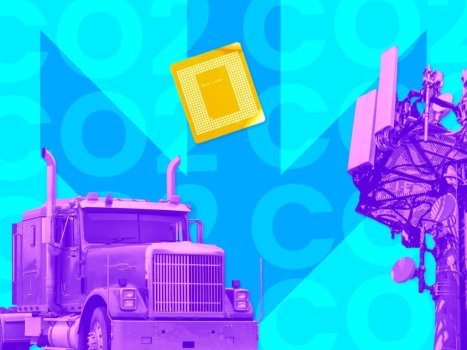K
Kathleen Martin
Guest
If we don’t reduce greenhouse gas emissions, the Earth will likely reach the disastrous 1.5-degree warming threshold between 2030 and 2052, says the Intergovernmental Panel on Climate Change (IPCC). As the single largest producer of greenhouse gasses, the transportation sector is central to any effort to improve the situation. But how?
No single technology is sufficient to avoid climate catastrophe, but cellular IoT can help reduce transportation’s carbon footprint in surprisingly powerful ways. If you work in transportation—from shipping to mass transit to personal mobility—think of IoT as a valuable part of your sustainability toolkit. But to get the most benefit, these systems must be sustainable across the whole lifecycle, starting with the production of IoT devices.
How can IoT device manufacturers help transportation providers reduce emissions without creating too much waste of their own? One area of focus is a new generation of subscriber identity module (SIM) technology: the integrated SIM, or iSIM. In this article, we’ll explain how IoT supports greener transportation options. Then, we’ll explore iSIMs as the most efficient path toward IoT-driven sustainability in this sector.
IoT’s Contributions to Sustainable Transportation Systems
The transportation industry includes every level of mobility, from passenger vehicles to freight carriers and agricultural equipment to e-scooters. Cellular IoT can help reduce emissions in each. Today’s IoT systems reduce transportation’s environmental footprint by:
1. Reducing Inventory Waste Throughout the Supply Chain.
Medium- and heavy-duty trucks contributed more than a quarter of the broader transportation sector’s greenhouse gas emissions in 2020. When freight gets damaged in transit, shippers have to manufacture and deliver replacement orders, effectively doubling the shipment’s carbon footprint. Cellular asset tracking technology delivers real-time data on the state and condition of shipments throughout their journeys, so shippers can make changes before damage occurs—correcting temperature imbalances in containers, removing shipments from humid warehouses, and more. Such actions prevent waste and associated carbon emissions.
Cellular asset tracking also supports the reuse of materials. For example, shippers and carriers traditionally regarded shipping pallets and crates as disposable. That’s changing. With rising material costs and the need to reduce overall shipping expenses and environmental impacts, the reuse of pallets and crates is becoming imperative. With pallets made of resilient, lightweight materials, and embedded with cellular IoT tracking and content-monitoring devices, the value of these assets increases—further driving widespread reuse.
With asset tracking driven by cellular IoT, haulers can locate and manage pallets efficiently, especially when they move outside the owner’s direct control.
2. Enabling More Energy-Efficient Routes and Fleet Management Decisions.
Without big data, micro-mobility providers struggle to spot use patterns. That leads to a lot of unnecessary fleet transportation. Fleet management platforms use data supplied by cellular IoT features to help you deploy e-scooters and e-bikes where they’ll be used without unnecessary hauling.
Continue reading: https://www.iotforall.com/iot-isim-sustainable-transportation
No single technology is sufficient to avoid climate catastrophe, but cellular IoT can help reduce transportation’s carbon footprint in surprisingly powerful ways. If you work in transportation—from shipping to mass transit to personal mobility—think of IoT as a valuable part of your sustainability toolkit. But to get the most benefit, these systems must be sustainable across the whole lifecycle, starting with the production of IoT devices.
How can IoT device manufacturers help transportation providers reduce emissions without creating too much waste of their own? One area of focus is a new generation of subscriber identity module (SIM) technology: the integrated SIM, or iSIM. In this article, we’ll explain how IoT supports greener transportation options. Then, we’ll explore iSIMs as the most efficient path toward IoT-driven sustainability in this sector.
IoT’s Contributions to Sustainable Transportation Systems
The transportation industry includes every level of mobility, from passenger vehicles to freight carriers and agricultural equipment to e-scooters. Cellular IoT can help reduce emissions in each. Today’s IoT systems reduce transportation’s environmental footprint by:
1. Reducing Inventory Waste Throughout the Supply Chain.
Medium- and heavy-duty trucks contributed more than a quarter of the broader transportation sector’s greenhouse gas emissions in 2020. When freight gets damaged in transit, shippers have to manufacture and deliver replacement orders, effectively doubling the shipment’s carbon footprint. Cellular asset tracking technology delivers real-time data on the state and condition of shipments throughout their journeys, so shippers can make changes before damage occurs—correcting temperature imbalances in containers, removing shipments from humid warehouses, and more. Such actions prevent waste and associated carbon emissions.
Cellular asset tracking also supports the reuse of materials. For example, shippers and carriers traditionally regarded shipping pallets and crates as disposable. That’s changing. With rising material costs and the need to reduce overall shipping expenses and environmental impacts, the reuse of pallets and crates is becoming imperative. With pallets made of resilient, lightweight materials, and embedded with cellular IoT tracking and content-monitoring devices, the value of these assets increases—further driving widespread reuse.
With asset tracking driven by cellular IoT, haulers can locate and manage pallets efficiently, especially when they move outside the owner’s direct control.
2. Enabling More Energy-Efficient Routes and Fleet Management Decisions.
Without big data, micro-mobility providers struggle to spot use patterns. That leads to a lot of unnecessary fleet transportation. Fleet management platforms use data supplied by cellular IoT features to help you deploy e-scooters and e-bikes where they’ll be used without unnecessary hauling.
Continue reading: https://www.iotforall.com/iot-isim-sustainable-transportation

